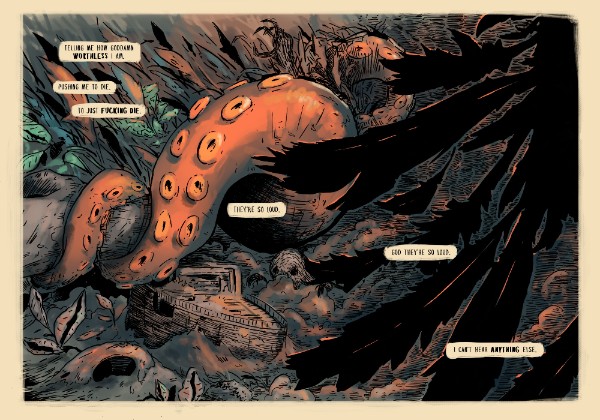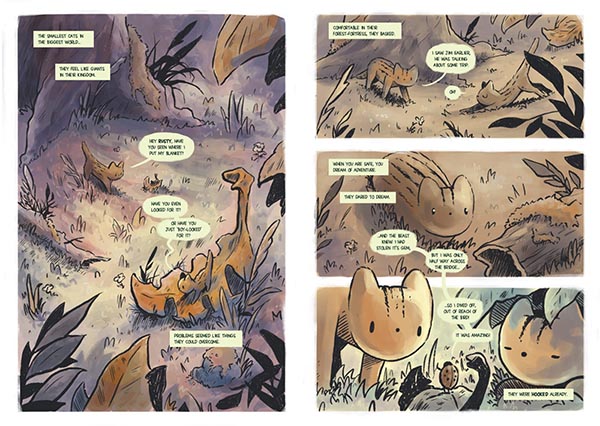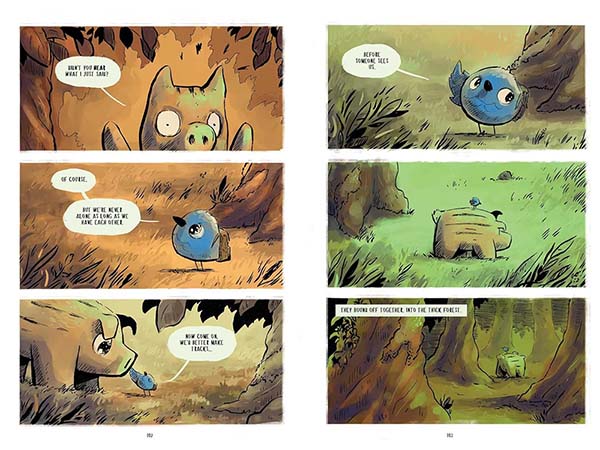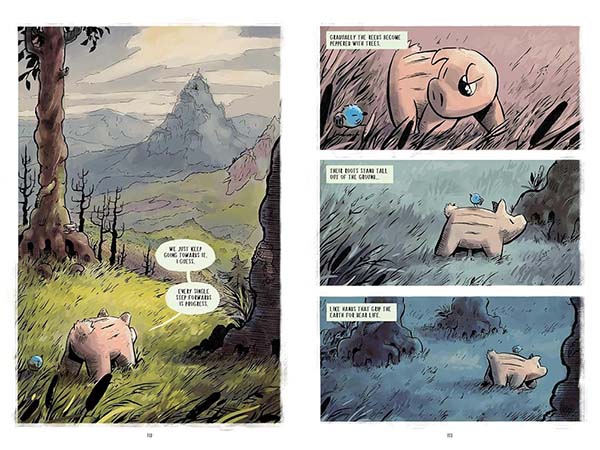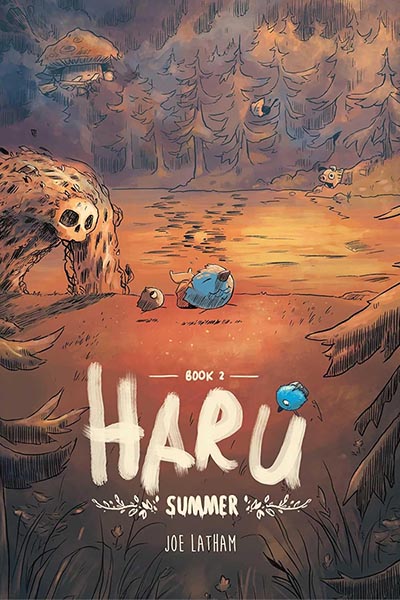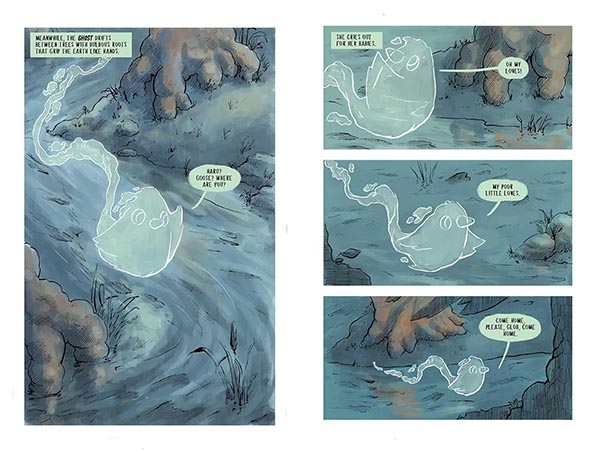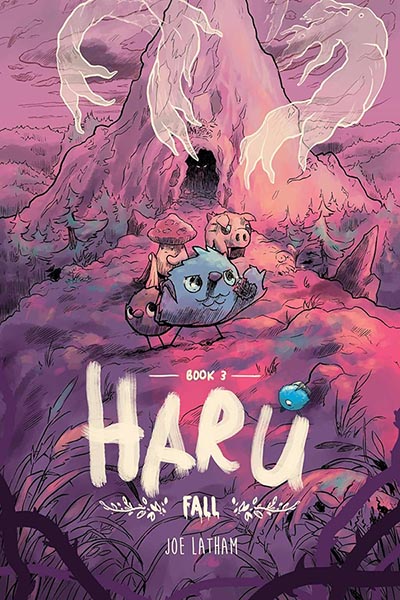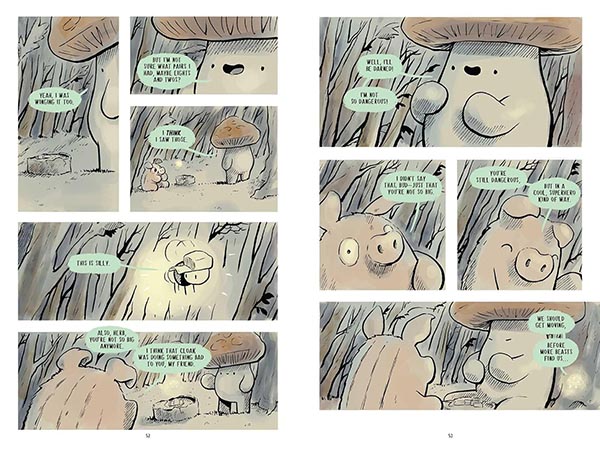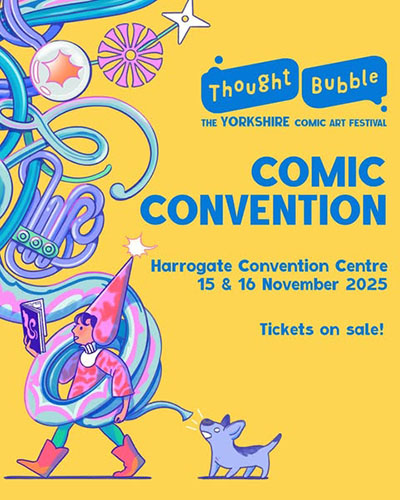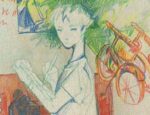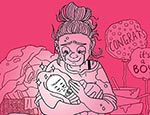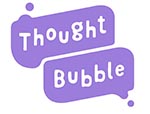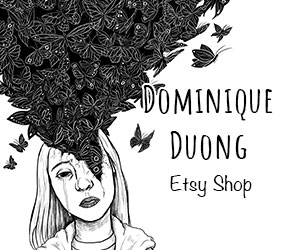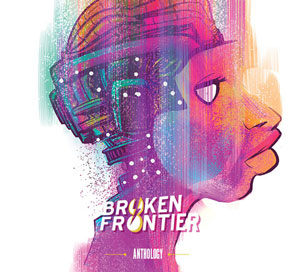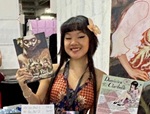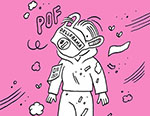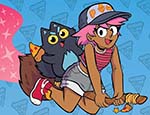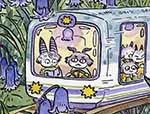THOUGHT BUBBLE MONTH 2025! After choosing the self-publishing route writer-artist Joe Latham came to much wider attention recently with his acclaimed Haru graphic novel trilogy from Andrews McMeel. I reviewed the first book last year here at Broken Frontier describing it as “an instant classic of its genre.” Today, ahead of his Thought Bubble appearance, Joe talks to us about that self-publishing journey, layered themes for different age groups, and what might be next on the comics horizon for him…

ANDY OLIVER: You began in comics self-publishing. Can you give us a potted history of your journey into the medium and how you made that transition from shorter strips to fully published comics creator?
JOE LATHAM: I did indeed! My background is actually in Graphic Design and Illustration. After university I was in a lowly band, with no money at all, and what felt like no prospects, so I started taking on any freelance work I could get. I ended up doing a lot of work for bands, album artwork, t-shirts, posters, which lead to doing more commercial design work and web design and development (every band member also had a job). This lead to many unusual short term gigs, such as designing Twitter graphics and facebook assets for UK celebrities such as Davina McCall, Vernon Kay, Ben Shepherd. Funny to NameDrop but the jobs earned me around £30 a pop.
From ‘Lustration & Other Stories’
Anyway, doing artwork for bands would often involve the clients asking me to essentially imitate another artist’s style (whom they couldn’t afford), which is pretty bad for self-confidence, because nothing looks good when you’re imitating someone else’s style. The flaws just get louder and louder, though it gave me a hunger to find my own voice.
From there I collaborated with my friend Luke Hyde to make a short graphic novel (Losing Sleep), which I wrote and Luke did the artwork. However the process of making that book slowed down when Luke landed a job, and I got somewhat restless and made another Graphic Novel, this time a silent comic (The Fox, The Wolf & The Woodsman), intentionally poetic to allow me space to lean into the art style as much as my impulses would allow. Both were self-published, but gave me the chance to go out and talk to people about my work.
A Seed Named Hope
The latter book landed me an agent with whom things did not go smoothly, for various reasons (none malicious) but that lead me to continue to self publish the first 2 chapters of Haru, which was such a joy to take out and talk to people about and hear their responses each time. This also helped me find a new agent, who helped me develop a strong pitch, and after a number of stop starts within the publishing world (another complicated tale) we subsequently found a happy home for Haru with Andrews McMeel. It’s hard to summarise so much work concisely and I’m not sure I was at all concise, yet I still feel like I missed an awful lot out. It’s a messy journey.
AO: Haru is, of course, your hugely acclaimed three graphic novel series published by Andrews McMeel. For new readers how would you describe its premise and the themes it explores?
LATHAM: My elevator pitch is: Haru is a Fantasy Adventure story about a small Blue Bird who cannot fly but must overcome tremendous adversity when a terrible dark force awakens and threatens their way of life. You may hear me say that many times at a convention (apologies if you hear it too many times). It’s a middle grade adventure in terms of marketing group, but I try to weave in more mature subtexts for grown-up readers too. So on the one hand, it’s a fantasy adventure about growing up, and on the other hand it’s about discovering your self-identity through the process of grief.
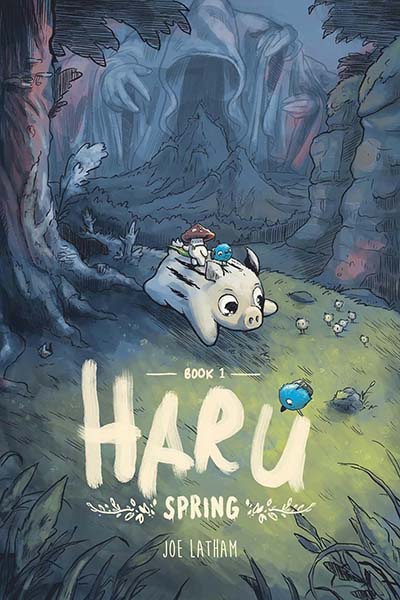
Haru: Book 1: Spring
AO: There’s something about Haru that makes it feel like a genuinely all-ages offering. That is, that it can be read by younger readers on one level but older readers may find whole other interpretive levels to enjoy it on. Am I reading too much into that or is there a conscious decision there to provide those different layers?
LATHAM: Thank you so much, this is a wonderfully worded and considered question, and you hit the nail on the head. When I started working on the story, I was focused on how it connected to me (in a poetic sense), and it kind of grew as I grew. Through various stages of life, including trauma, loss, the pandemic, some tremendously painful moments that deeply tied me to the story. My own internal rules were: ‘no swearing, and no gore’ and I really feel like you can tell almost any kind of story within those parameters.
In my previous answer I mentioned how it’s a fantasy adventure about growing up, but the mature subtexts are about discovering your self-identity through the process of grief. I think working on a longer form of storytelling personal connections form naturally, but it was always something I wanted to do, to anchor myself to the work, but also leave that space there for readers to find their own connection to it too.
Haru: Book 1: Spring
The trick is to try and be specific enough so that people relate, but be poetic enough so that it doesn’t alienate anyone. You never really know if you’ve achieved that, but I guess time will tell. Part of the joy of books is the life they take on once they’re published too, and people can form their own relationships with them. I don’t want to dilute anyone’s reading of Haru, but I do love trying to weave in more layers.
Another example, and I’m not sure if this is going to be too ‘on the nose’ or not, but while writing the script for the third book, I became somewhat fascinated with Dante Alighieri’s Divine Comedy, with Gustav Dore’s illustrations. Dante said that his work can be read on three levels; the poetic, the allegorical, and the literal. I found that so inspiring, and I hope you could say something similar about Haru.
Haru: Book 1: Spring
AO: Colour plays such a vital role in your work. Can you tell us how you use it in your storytelling as a tool to create mood and communicate theme, especially in the pages of Haru?
LATHAM: Absolutely, well firstly I love the idea that the creator or artist is setting the rules of the book, so you can also decide when to bend or break those rules too. In the first 3 chapters, since I was self-publishing them with a slight break between each one, I used it to try and experiment with how much impact colour can have emphasise moments, to try and make scenes distinctly recognisable from one another, and push the mood as far as I can within my own capabilities.
This way the reader is never confused about where they are in the story, but you can also make them feel cosy, or uneasy, just by leaning into your colour choices. I started by planning some basic colour concepts to try to stick to throughout the book, and that grew to incorporate environments almost as characters themselves, and grew further when trying to consider the impact of light and colour shifts. Leaning in to the feelings to try and make it is engaging as possible for the reader, and try and invoke strong emotional connections.
Haru: Book 2: Summer
AO: Give us the lowdown on your creative process. What mediums do you work in to bring Haru to the page?
LATHAM: It’s funny, but this is one aspect I was always fascinated to read about other artists but feel kind of embarrassed when discussing my own process. I’m not sure why that is, but here we go…
So I write everything pen on paper, long hand first. Then I type it up and try to do a first pass at editing as I go. Then I print that out, make notes on it, try to break it down by page and spread, work out where the key moments are and how to give them the space they need. Then I sketch thumbnails, just a few inches big for each page, but this stage still takes ages. Then I draw the roughs in blue pencil on cheap copier paper, then I usually tighten that up with a mechanical pencil. Then I scan that, turn it back into blue line, and print it onto Smooth Finish Watercolour paper (because I find I make a lot of mistakes and mess on Bristol board, but Smooth finish/hot press watercolour paper has slight tooth to it which just seems to hold the ink better for me).
Haru: Book 2: Summer
I ink traditionally, these days mostly using a Pentel Brush Pen, and a Pilot Gtec black pen, though I also have a lot of stationery I like to use, a Pilot fountain pen, a couple of kuretake brush pens, a Kalinsky sable brush with black ink, a deleter dip pen with zebra nib. Whatever tools work to make the process feel calming and flow, those are the tools I consistently go back to, and feel excited to pick up again and again no matter what kind of day I’ve had. That’s how big books get made, when the tools feel easy and enjoyable to work with.
Then finally I scan that, and colour it in usually using Photoshop, but again I have a number of different programs I use, but Photoshop is the one I have the most history with and feels the easiest to use. I letter using InDesign, though I also sometimes hand letter using photoshop, depending on the specifics of the panel.
Haru: Book 3: Fall
AO: The final book in the Haru series is debuting this Autumn. Do you have any plans for revisiting that world?
LATHAM: It is, I should also have some copies of the final book at Thought Bubble in fact. There has been interest in a fourth book, and I have the early stages of something simmering, I’m not 100% sure either way at the moment. It’s definitely a possibility, but for now the story is told. At least, this part of the story is told.
AO: Have you thought about your next big comics project yet?
LATHAM: Non-stop. Though I must admit that is also where the problem lies. Since finishing work on the third book I’ve felt somewhat adrift, not sure how to promote the upcoming book, since the publisher is based in the US and I’m in the UK, I’ve also been a little pulled away from comics by freelance work for a few weeks, which I had postponed while finishing up the book, and subsequently spinning between too many ideas that I hadn’t finished cooking. Suddenly it feels like there’s nowhere near enough time in the days or weeks to get my thoughts together.
Haru: Book 3: Fall
In many ways this is the exciting and fertile place to be, because I have a few things building and growing. I’m just not entirely sure exactly what they’re going to be right now. I think the next thing from me in the short term will be the second chapter of The Eternal Mountain (self-published at the moment), which is also a fantasy adventure story, this time about a Ranger Frog on a journey up a mountain in pursuit of revenge. Another layered story with mature subtexts. Everyone has a mountain to climb hey?! Beyond that, we shall see over the next few months I think.
Interview by Andy Oliver
Visit Joe Latham’s website and online store here
Joe Latham will be at Table B42 in the 2000 AD Hall at Thought Bubble.
Thought Bubble 2025 runs from November 1oth-16th with the convention weekend taking place on the 15th-16th. More details on the Thought Bubble site here.
Read all our Thought Bubble 2025 coverage so far in one place here.
Poster by Ng Yin Shian





